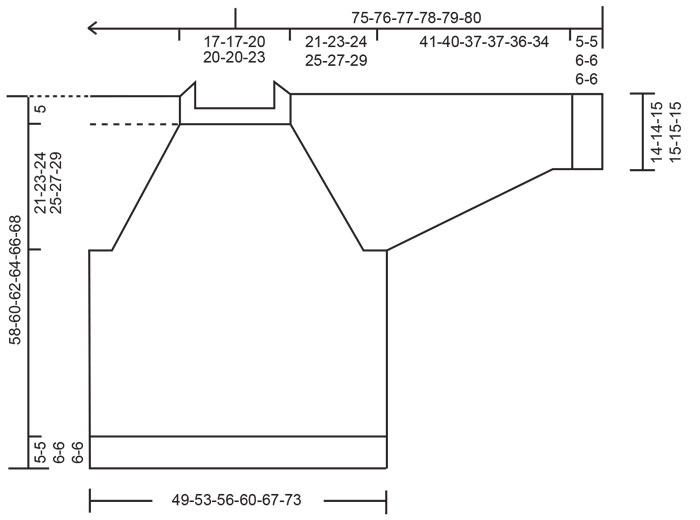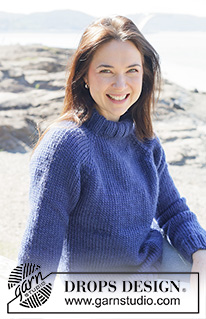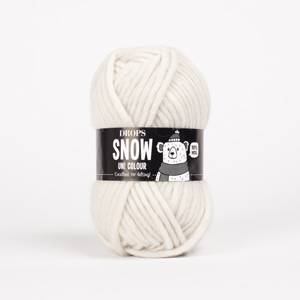Comments / Questions (4)
![]() Giusy wrote:
Giusy wrote:
Ciao, sto terminando il maglione da uomo Ocean Ropes: Modello me-258. Devo fare il colloe mi so fermata xche non capisco quante maglie devo riprendere attorno alla scollatura. Ci sono due numeri: 124-134. Per la taglia L, quante maglie devo riprendere? 124 oppure 134? Grazie per la risposta
16.04.2025 - 12:55DROPS Design answered:
Buonasera Giusy, ha scritto il commento sotto il modello sbagliato: in questo modo si genera confusione anche per le altre clienti. In ogni caso, i numeri indicati sono un intervallo di maglie da riprendere. Buon lavoro!
16.04.2025 - 22:44
![]() Ruth Evans wrote:
Ruth Evans wrote:
I’d like to knit this jumper in stripes rather than plain, using a selection of colours, textures and stitches. I hope to use two combinations of 2x group C strands: either 2 of Paris, or 1 of Paris + 1 of Brushed Alpaca Silk. Would these combinations work as a replacements for 1 strand of Snow? I’m concerned that Paris might be too different a texture for it to be a good replacement. Thank you.
14.01.2025 - 23:06DROPS Design answered:
Dear Mrs Evans, the texture will be different depending on the yarn chosen but technically from tension it should work - use the yarn converter to see alternatives and help with the amount of yarn. You can always first work a swatch before to check the tension but also to check the texture and choose which yarn you would rather use instead. Happy knitting!
15.01.2025 - 09:03
![]() Nes wrote:
Nes wrote:
Hello, after finishing the neck and starting the yoke the first line wants me to decrease two stitches on the 12 ones reserved for the arms, does that mean one at the beginning of the 12 and one at the end? And where am I supposed to divide to get the raglan stitch? Because if I decrease and mark out the front and the back I will get the 68 required stitches but I don’t know witch one of them is the one used for the raglan
09.12.2024 - 13:39DROPS Design answered:
Hi Nes, first question – evenly means in regular spaces, not necessarily at the beginning and at the end of the 12 stitches reserved for the arms. Second question: insert 4 marker threads in the piece (as stated in the pattern) while working first round, insert marker threads on row between 2 knit stitches, and these 2 stitches are called raglan stitches. So you have 2 knit stitches in each raglan. Happy knitting! For raglan increases you will make 1 yarn over before and after 2 raglan stiches. Happy knitting!
10.12.2024 - 09:40
![]() Delphine wrote:
Delphine wrote:
Bonjour, ai-je mal compris les instructions en début d'empiècement ou y a-t-il une erreur ? 12 (manches) x 2 + 20 (dos/devant) x 2 = 64 et non 60.
13.11.2024 - 08:34
Sapphire Sea Sweater#sapphireseasweater |
|
 |
 |
Knitted jumper in DROPS Snow. Piece is knitted top down in stocking stitch with raglan. Size: S - XXXL
DROPS 254-31 |
|
|
---------------------------------------------------------- EXPLANATION FOR THE PATTERN: ---------------------------------------------------------- RAGLAN: Increase 1 stitch by making 1 yarn over, on next round knit yarns over as explained below: BEFORE RAGLAN STITCHES: Slip stitch off left needle and put it back on left needle but the opposite way (insert left needle in from behind when slipping it back on needle). Knit yarn overs in front loop of stitches to avoid holes. Then work the new stitches in stocking stitch. AFTER RAGLAN STITCHES: Knit yarn overs in back loop of stitches to avoid holes. Then work the new stitches in stocking stitch. SLEEVE TIP: When picking up stitches mid under sleeve, there will be a small hole in the transition between stitches on body and sleeves. The holes can be closed by picking up the strand between two stitches - work this strand twisted together with the first stitch between body and sleeve so that the holes closes. DECREASE TIP: Decrease 1 stitch on each side of marker thread as follows: Work until 3 stitches remain before marker thread and knit 2 together, knit 2 (marker thread is in the middle of these 2 stitches), slip 1 stitch knitwise, knit 1, pass slipped stitch over stitch worked (= 2 stitches decreased). ---------------------------------------------------------- START THE PIECE HERE: ---------------------------------------------------------- JUMPER - SHORT OVERVIEW OF THE PIECE: In this pattern needles of different length have been used, begin with fitting length for number of stitches and switch as needed. Work neck edge and yoke in the round on circular needle from right shoulder back, and work top down. When yoke is done, divide piece for body and sleeves. Work body down wards in the round on circular needle while putting the sleeves aside. Then work sleeves downwards in the round on needle. Fold the neck edge double against the wrong side and fasten. If 0 is given for the chosen size, it means that you skip the information until next information. NECK EDGE: Cast on 64-64-72-72-72-80 stitches on circular needle size 8 mm with DROPS Snow. Switch to circular needle size 6 mm (cast on on a larger needle to get an elastic cast-on edge). Work rib in the round as follows: Knit 1, * purl 2, knit 2 *, work from *-* until 3 stitches remain on round, purl 2, knit 1. Work rib until piece measures 9-9-11-11-11-11 cm. Later the neck edge is folded in towards wrong side and assembled to form a neck edge of approx. 4-4-5-5-5-5 cm. Beginning of round is at right shoulder at the back. Insert 1 marker after the first 23-23-25-25-25-27 stitches on round (= approx. mid front), measures piece from this marker. YOKE: Continue with circular needle size 8 mm. Insert 4 marker threads in the piece while working first round, insert marker threads on row between 2 knit stitches, and these 2 stitches are called raglan stitches. Work first round in stocking stitch as follows: Insert 1st marker thread at the beginning of round, work 12 stitches while AT THE SAME TIME decreasing 2-2-0-2-2-2 stitches evenly over these stitches (= sleeve), insert 2nd marker thread before next stitch, work 20-20-24-24-24-28 stitches (= front piece), insert 3rd marker thread before next stitch, work 12 stitches while AT THE SAME TIME decreasing 2-2-0-2-2-2 stitches evenly over these stitches (= sleeve), insert 4th marker thread before next stitch, work 20-20-24-24-24-28 stitches (= back piece) = 60-60-72-68-68-76 stitches on needle. Work in stocking stitch in the round and increase for RAGLAN on each side of raglan stitches – read explanation above (= 8 stitches increased). Increase for raglan every other round 14-16-16-17-19-20 times in total = 172-188-200-204-220-236 stitches. Remember to follow the knitting tension! Continue with stocking stitch without increase until piece measures 21-23-24-25-27-29 cm from marker mid front. Now divide yoke for body and sleeves. DIVIDING FOR BODY AND SLEEVES: AT THE SAME TIME as next round is worked divide yoke for body and sleeves as follows: Work 1-1-1-1-2-2 stitches (belongs to back piece), slip the next 36-40-42-42-44-46 stitches on a thread for sleeve, cast on 4-4-4-6-8-8 new stitches on needle (= in the side mid under sleeve), work 50-54-58-60-66-72 stitches in stocking stitch (= front piece), slip the next 36-40-42-42-44-46 stitches on a thread for sleeve, cast on 4-4-4-6-8-8 new stitches on needle (= in the side mid under sleeve) and work the last 49-53-57-59-64-70 stitches in stocking stitch (= back piece). Finish body and sleeves separately. BODY: = 108-116-124-132-148-160 stitches. Insert 1 marker in one side of piece (= in the middle of the 4-4-4-6-8-8 stitches that were cast on under sleeve). Work until marker, round begins here and work in the round. Work stocking stitch until piece measures 48-50-51-53-55-57 cm from marker mid front. Switch to circular needles size 6 mm, work rib (= knit 2/purl 2) while AT THE SAME TIME increasing 32-36-36-40-44-48 stitches evenly on 1st round = 140-152-160-172-192-208 stitches. When rib measures 5-5-6-6-6-6 cm, cast off all stitches somewhat loosely with knit over knit and purl over purl. Jumper measures 53-55-57-59-61-63 cm from marker mid front and approx. 58-60-62-64-66-68 cm from the top of shoulder. SLEEVES: Slip 36-40-42-42-44-46 sleeve stitches from one thread on to circular needle size 8 mm and pick in addition up 1 stitch in each of the 4-4-4-6-8-8 stitches cast on under sleeve = 40-44-46-48-52-54 stitches. Insert 1 marker thread in the middle of the 4-4-4-6-8-8 new stitches under sleeve - round begins at the marker thread. Work in stocking stitch in the round on needle - read SLEEVE TIP. When sleeve measures 2 cm from division, decrease mid under sleeve – read DECREASE TIP and decrease as follows: Decrease 2 stitches every 8-6-5-4½-4-3 cm 5-7-7-8-9-10 times in total = 30-30-32-32-34-34 stitches. Work until sleeve measures 41-40-37-37-36-34 cm from division. Switch to double pointed needles size 6 mm and work rib (= knit 2/purl 2) while AT THE SAME TIME increasing 6-6-8-8-10-10 stitches evenly on 1st round = 36-36-40-40-44-44 stitches. When rib measures 5-5-6-6-6-6 cm, cast off all stitches somewhat loosely with knit over knit and purl over purl. Sleeve measures approx. 46-45-43-43-42-40 cm from division. ASSEMBLY: Fold the rib down on inside of garment. Fasten rib with a couple of stitches. |
|

|
|
Have you finished this pattern?Tag your pictures with #dropspattern #sapphireseasweater or submit them to the #dropsfan gallery. Do you need help with this pattern?You'll find 27 tutorial videos, a Comments/Questions area and more by visiting the pattern on garnstudio.com. © 1982-2025 DROPS Design A/S. We reserve all rights. This document, including all its sub-sections, has copyrights. Read more about what you can do with our patterns at the bottom of each pattern on our site. |
|












































































Post a comment to pattern DROPS 254-31
We would love to hear what you have to say about this pattern!
If you want to leave a question, please make sure you select the correct category in the form below, to speed up the answering process. Required fields are marked *.